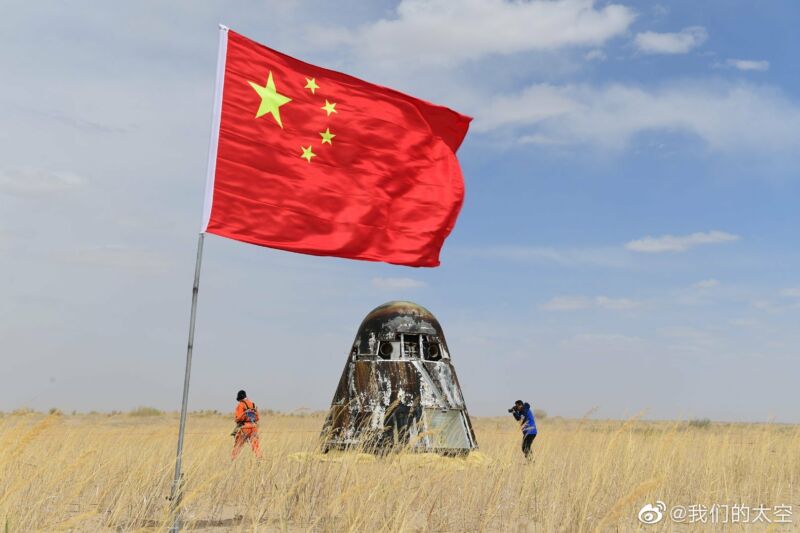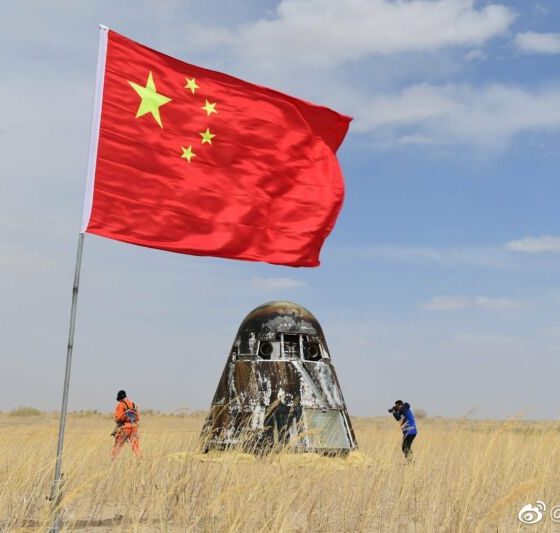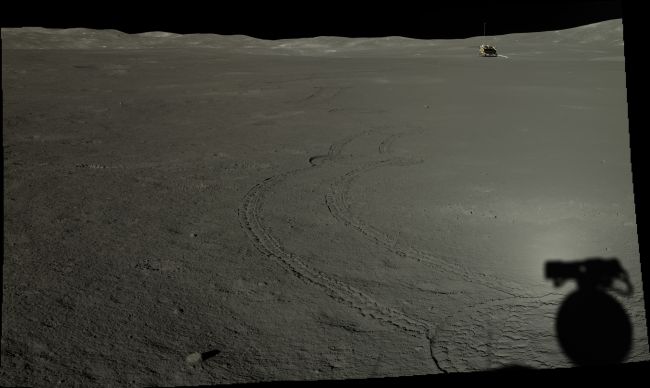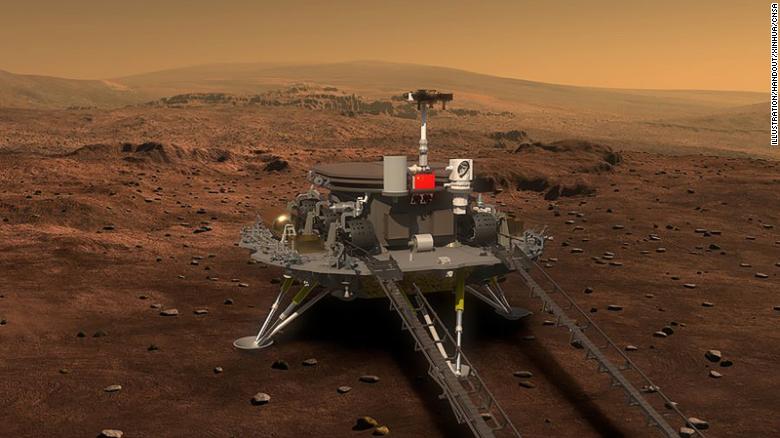

News
China completes test flight of new spacecraft that resembles SpaceX Crew Dragon
China’s new uncrewed spacecraft successfully landed back on Earth on Friday, May 8, following a three-day mission. It touched down intact with the help of a trio of parachutes, making landfall in the Chinese desert at 1:49 a.m. ET (0549 UTC). The Chinese space agency released photos soon after that showed a spacecraft resembling a toasty marshmallow.
If you think have you deja vu while looking at this image, you’re not wrong. The new Chinese spacecraft resembles another spacecraft that is soon to carry its first crew of astronauts into space. That’s right; it looks similar to SpaceX’s Dragon capsule.
The mission is one of the first steps the Chinese are taking to prepare for future lunar missions. The spacecraft launched atop a Long March 5B — China’s most powerful rocket. During the test, the spacecraft soared to an altitude of nearly 5,000 miles above the Earth. The trial, which was similar to the initial flight test of Orion that NASA completed in late 2014, was heralded as a success.
China has not revealed any detailed plans for its deep space ambitions, but we do have a rough idea of what the country and its space program hope to achieve. With the help of the Long March 5B, China aims to build its space station in low-Earth orbit sometime in the new few years.
It’s been rumored that this new spacecraft will probably play some sort of role in the development and maintenance of this future space station.
China also has big plans for the moon and even Mars. The China Aerospace and Technology Corp is building an even larger Dragon-like spacecraft that could one day transport taikonauts (Chinese astronauts) to the moon. Chinese officials have expressed their desires to build a lunar outpost in the future as well as eventually send humans on to Mars.
The country made history in 2019 when it became the first to land a rover on the far side of the moon. Ever since the Chang’e 4 lander along with its Yutu 2 rover have been beaming back incredible photos of the lunar surface as well as taking scientific measurements.

But China’s lunar plans do not stop there. Although specific details and dates are scarce, the country has mentioned the notion of lunar landing sometime in the 2030s.
If all goes as planned, this summer, NASA will not be the only space agency sending a rover to Mars. The UAE also has plans to send a spacecraft to the red planet. The Hope spacecraft will launch from Japan this summer and spend two years studying the Martian atmosphere.
NASA’s Perseverance Mars rover will also launch in July and is expected to touch down on the red planet’s surface in Feb. 2021,it a region is known as Jezero Crater. Once it arrives, it will search for signs of past life, while collecting samples of Martian rock and soil to send back to Earth at a later time.

China is also expected to launch a spacecraft to Mars this summer. The Chinese space agency recently revealed that this mission would be called “Tianwen 1,” which means the quest for heavenly truth. To date, only the U.S. and the former Soviet Union have landed spacecraft on Mars. However, both the European Space Agency and the Indian Space Research Organization (ISRO) have operational spacecraft orbiting the red planet.
The Chinese spacecraft will consist of three parts: an orbiter, a stationary lander, and a six-wheeled rover. Together the trio will study the Martian atmosphere, analyze the regolith and rocks, as well as try to better understand the Martian environment as a whole.

News
Tesla FSD fleet is nearing 7 billion total miles, including 2.5 billion city miles
As can be seen on Tesla’s official FSD webpage, vehicles equipped with the system have now navigated over 6.99 billion miles.

Tesla’s Full Self-Driving (Supervised) fleet is closing in on almost 7 billion total miles driven, as per data posted by the company on its official FSD webpage.
These figures hint at the massive scale of data fueling Tesla’s rapid FSD improvements, which have been quite notable as of late.
FSD mileage milestones
As can be seen on Tesla’s official FSD webpage, vehicles equipped with the system have now navigated over 6.99 billion miles. Tesla owner and avid FSD tester Whole Mars Catalog also shared a screenshot indicating that from the nearly 7 billion miles traveled by the FSD fleet, more than 2.5 billion miles were driven inside cities.
City miles are particularly valuable for complex urban scenarios like unprotected turns, pedestrian interactions, and traffic lights. This is also the difference-maker for FSD, as only complex solutions, such as Waymo’s self-driving taxis, operate similarly on inner-city streets. And even then, incidents such as the San Francisco blackouts have proven challenging for sensor-rich vehicles like Waymos.
Tesla’s data edge
Tesla has a number of advantages in the autonomous vehicle sector, one of which is the size of its fleet and the number of vehicles training FSD on real-world roads. Tesla’s nearly 7 billion FSD miles then allow the company to roll out updates that make its vehicles behave like they are being driven by experienced drivers, even if they are operating on their own.
So notable are Tesla’s improvements to FSD that NVIDIA Director of Robotics Jim Fan, after experiencing FSD v14, noted that the system is the first AI that passes what he described as a “Physical Turing Test.”
“Despite knowing exactly how robot learning works, I still find it magical watching the steering wheel turn by itself. First it feels surreal, next it becomes routine. Then, like the smartphone, taking it away actively hurts. This is how humanity gets rewired and glued to god-like technologies,” Fan wrote in a post on X.
News
Tesla starts showing how FSD will change lives in Europe
Local officials tested the system on narrow country roads and were impressed by FSD’s smooth, human-like driving, with some calling the service a game-changer for everyday life in areas that are far from urban centers.

Tesla has launched Europe’s first public shuttle service using Full Self-Driving (Supervised) in the rural Eifelkreis Bitburg-Prüm region of Germany, demonstrating how the technology can restore independence and mobility for people who struggle with limited transport options.
Local officials tested the system on narrow country roads and were impressed by FSD’s smooth, human-like driving, with some calling the service a game-changer for everyday life in areas that are far from urban centers.
Officials see real impact on rural residents
Arzfeld Mayor Johannes Kuhl and District Administrator Andreas Kruppert personally tested the Tesla shuttle service. This allowed them to see just how well FSD navigated winding lanes and rural roads confidently. Kruppert said, “Autonomous driving sounds like science fiction to many, but we simply see here that it works totally well in rural regions too.” Kuhl, for his part, also noted that FSD “feels like a very experienced driver.”
The pilot complements the area’s “Citizen Bus” program, which provides on-demand rides for elderly residents who can no longer drive themselves. Tesla Europe shared a video of a demonstration of the service, highlighting how FSD gives people their freedom back, even in places where public transport is not as prevalent.
What the Ministry for Economic Affairs and Transport says
Rhineland-Palatinate’s Minister Daniela Schmitt supported the project, praising the collaboration that made this “first of its kind in Europe” possible. As per the ministry, the rural rollout for the service shows FSD’s potential beyond major cities, and it delivers tangible benefits like grocery runs, doctor visits, and social connections for isolated residents.
“Reliable and flexible mobility is especially vital in rural areas. With the launch of a shuttle service using self-driving vehicles (FSD supervised) by Tesla in the Eifelkreis Bitburg-Prüm, an innovative pilot project is now getting underway that complements local community bus services. It is the first project of its kind in Europe.
“The result is a real gain for rural mobility: greater accessibility, more flexibility and tangible benefits for everyday life. A strong signal for innovation, cooperation and future-oriented mobility beyond urban centers,” the ministry wrote in a LinkedIn post.
News
Tesla China quietly posts Robotaxi-related job listing
Tesla China is currently seeking a Low Voltage Electrical Engineer to work on circuit board design for the company’s autonomous vehicles.

Tesla has posted a new job listing in Shanghai explicitly tied to its Robotaxi program, fueling speculation that the company is preparing to launch its dedicated autonomous ride-hailing service in China.
As noted in the listing, Tesla China is currently seeking a Low Voltage Electrical Engineer to work on circuit board design for the company’s autonomous vehicles.
Robotaxi-specific role
The listing, which was shared on social media platform X by industry watcher @tslaming, suggested that Tesla China is looking to fill the role urgently. The job listing itself specifically mentions that the person hired for the role will be working on the Low Voltage Hardware team, which would design the circuit boards that would serve as the nervous system of the Robotaxi.
Key tasks for the role, as indicated in the job listing, include collaboration with PCB layout, firmware, mechanical, program management, and validation teams, among other responsibilities. The role is based in Shanghai.
China Robotaxi launch
China represents a massive potential market for robotaxis, with its dense urban centers and supportive policies in select cities. Tesla has limited permission to roll out FSD in the country, though despite this, its vehicles have been hailed as among the best in the market when it comes to autonomous features. So far, at least, it appears that China supports Tesla’s FSD and Robotaxi rollout.
This was hinted at in November, when Tesla brought the Cybercab to the 8th China International Import Expo (CIIE) in Shanghai, marking the first time that the autonomous two-seater was brought to the Asia-Pacific region. The vehicle, despite not having a release date in China, received a significant amount of interest among the event’s attendees.








